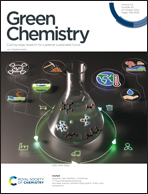CO2-responsive surfactants for switchable Pickering emulsions with a recyclable aqueous phase†
Abstract
Residual surfactants in the oil phase after demulsification may cause several problems, such as self-emulsification of the oil and contamination of oil-soluble products. Due to the amphipathic properties of surfactants, recycling and reuse of surfactants from emulsions and related systems without leaving their residues in the oil phase remains challenging. Here, we report a novel CO2-switchable surfactant (11-(N,N-dimethylamino) sodium undecanoate, NCOONa), which can stabilize CO2-switchable Pickering emulsions together with a trace amount of alumina nanoparticles (0.1 wt%). Rapid and complete demulsification of Pickering emulsions can be achieved by bubbling CO2, in which NCOONa is converted into a more hydrophilic inactive form (N+COONa) that almost completely enters the aqueous phase, avoiding residual surfactant in the oil phase. Moreover, the aqueous phase containing NCOONa and alumina particles can be recovered and reused after removal of CO2 by bubbling N2 at ambient temperature. This method represents a green and effective strategy for emulsion separation and oil product purification, and will have potential applications in biphasic catalysis, oil transportation, and emulsion extraction.



 Please wait while we load your content...
Please wait while we load your content...